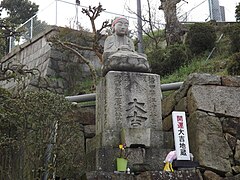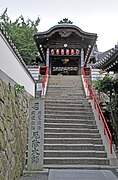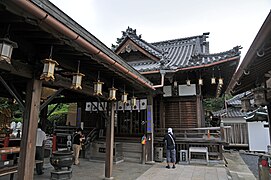Gōshō-ji (Utazu)
The Gōshō-ji ( Japanese 郷 照 寺 ) with the Go Bukkōzan (仏 光山) and Kōtokuin (広 徳 院) in Utazu ( Kagawa Prefecture ) is a temple of the Shingon direction of Buddhism. In the traditional count it is the 78th temple on the Shikoku pilgrimage route .
history
The temple was built in the 2nd year of Jinki, i.e. 725 by priest Gyōgi under the name Dōjō-ji (道場 寺). On this occasion he donated a self-made, 55 cm tall Amida Buddha figure. In 807, Priest Kūkai visited the temple, created a wooden self-portrait on the occasion and asked that all evil should go away. This figure, known as the "Grand Priest who dispels evil" (厄 除 う た づ 大師, Yakuyoke utazu Daishi) is worshiped by many to this day.
The temple was destroyed during the armed conflict in the 16th century. It was then Matsudaira Yorishige (松 平 頼 重 高; 1622–1695), Prince of Takamatsu, who took care of the temple, which was given its current name at the time.
investment
Even in front of the temple you pass the Daikichi Jizō (大吉 地 蔵; 1), the saint who is supposed to bring happiness to the poor. Then you pass the simple temple gate (山門, Sammon; 2) and continue to the stairs on the left that lead to the temple grounds. Immediately to the left is the bell tower (鐘楼, Shōrō; 3) on the right side you can see the main hall (本 堂, Hondō; 4) and in front of it on the right the Kōshin Pavilion (庚申 堂, Kōshindō; 5), which is dedicated to the Kōshi belief .
If you pass the main hall on the left side, past the monks' quarters (8) with its convertible garden, you reach the Yakuyoke Daishidō (厄 除 大師 堂; Yakuyoke Daishidō; 6), via a staircase and a covered entrance , to the hall in the Temple founder is thought, here with the addition "evildoer". Further above is the Awashimadō (粟 島 堂; 7), which is dedicated to the Awashima pilgrims. From up there you have a beautiful view of the Seto Inland Sea .
Treasures
The temple treasures include the seated wooden figure of the Amida Buddha (木造 阿 弥陀 如 来 坐像), which is registered as a cultural asset of the prefecture. It is made of cypress wood and dates from the Kamakura period . The colored painting on silk should also be mentioned, a Buddha trinity with two listeners (絹本 著色 釈 迦 三尊 二 声聞 図, Kimmoku chakushiki Shaka sanzon shōmon zu). You can see Buddha, accompanied by a lion riding holy Monju (文殊 菩薩) and an elephant riding Fugen (普賢 菩薩), and two monks.
photos
Remarks
- ↑ Koshin is a day in the East Asian 60-year cycle that, like the years, repeats every 60 days. On this day the believers try to stay awake in order to prevent the Sanshi (三 尸), beings who live in the body, from leaving the body to report the wickedness of the person to the gods. Here the Shōmen Kongō (青 面 金剛) and the three monkeys (三 猿) are worshiped.
literature
- Kagawa-ken no rekishisampo henshu iinkai (ed.): Gōshō-ji . In: Kagawa-ken no rekishi sampo. Yamakawa Shuppan, 2013. ISBN 978-4-634-24637-9 . Page 132.
- Oguri, Doei: Kukai. Shikoku hachijuhachi kosho no arukikata. Chukei no Bunko, 2011. ISBN 978-4-8061-4067-2 .
Web links
Coordinates: 34 ° 18 '24.1 " N , 133 ° 49' 28.5" E








